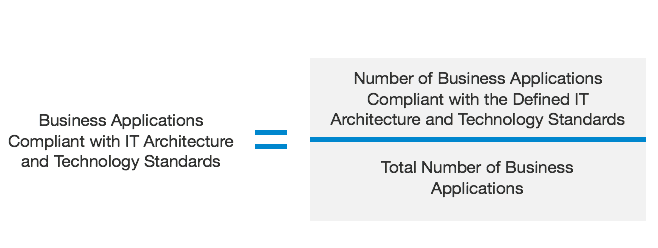EAM Key Performance Indicators (KPIs) are used to measure EAM goal achievement [Mat+12].
KPI Foundations
EAM goals are the starting point for deciding which EAM activities to conduct. To validate the success of such activities, their impact on the goal fulfillment needs to be measured. A prominent means to enable this measurement is the use of key performance indicators (KPIs) [Mat+12].
More precisely, KPIs can be used to quantify the performance and the complexity of enterprise architecture landscape [Ale+15]. By comparing a metric before starting and after finishing an EAM initiative, the initiative’s impact on the goal achievement can be measured. Additionally, benchmark values for metrics can be used to assess the current status of an enterprise architecture and to reveal if there is any need for action.
Together with each defined KPI, also the measurement frequency, a target, planned and tolerated value as well as clear escalation rules need to be determined. It is the enterprise architects task to ensure that the relevant data needed to compute these KPIs is available [Ale+15].
In summary, KPIs enable controlling of EAM activities [Mat+12].
An example of a KPI taken from the EAM KPI Catalog create at the Technische Universität München is “Business applications compliant with IT architecture and technology standards”. EAM goals that can be measured using this metric are the insurance of business application compliance as well as an increased transparency of the application landscape. The calculation of the KPI is depicted in Figure 1 [Mat+12].

Figure 1: Calculation of the KPI ``Business applications compliant with IT architecture and technology standards'' [Source: F. Matthes, I. M. Ivan, A. Schneider, and C. Schulz. EAM KPI Catalog v 1.0. Tech. rep. Munich: Chair for Software Engineering of Business Information Systems. Technische Universität München., 2012.]
Further examples of KPIs are the Total Cost of Ownership (TOC) of an application [BBL12], Strategic Fit (SF) of an application [BBL12], Value Contribution (VC) of an application [BBL12], Fan-in and Fan-out of an application [BBL12], Degree of Standardization [Man10], Function Redundancies [Man10] and Total Number of applications [Man10].
An extensive list of 52 literature-based and practice-proven EAM KPIs can be found in [Mat+12].
Sources:
| [Mat+12] |
F. Matthes, I. M. Ivan, A. Schneider, and C. Schulz. EAM KPI Catalog v 1.0. Tech. rep. Munich: Chair for Software Engineering of Business Information Systems. Technische Universität München., 2012. |
| [Ale+15] |
P. Aleatrati Khosroshahi, M. Hauder, A. W. Schneider, and F. Matthes. Enterprise Architecture Management Pattern Catalog V2. Tech. rep. Munich, Germany: Technichal University of Munich (TUM), 2015. |
| [Man10] |
T. Mannmeusel. “EAM im Mittelstand.” In: Enterprise Architecture Management (EAM) in der Praxis. Düsseldorf: Symposion Publishing GmbH, 2010, pp. 331–376. |
| [BBL12] |
S. Bente, U. Bombosch, and S. Langade. Collaborative Enterprise Architecture: Enriching EA with Lean, Agile, and Enterprise 2.0 Practices. Elsevier, Inc., 2012. |